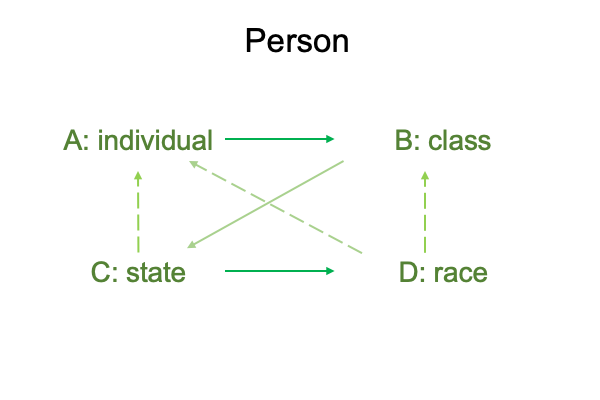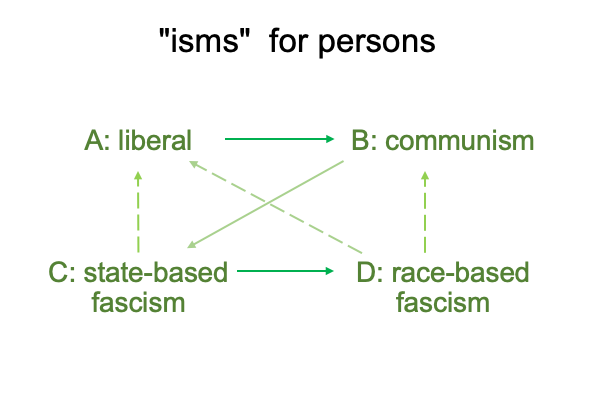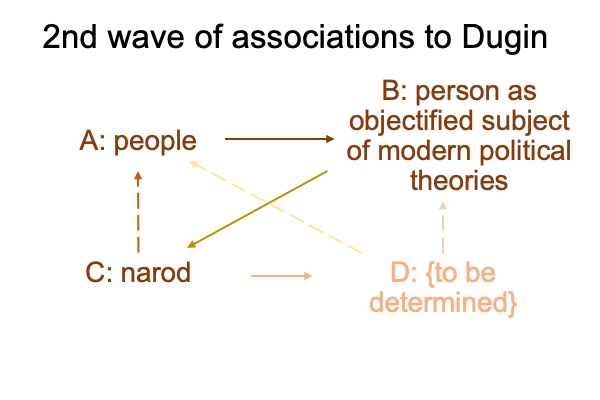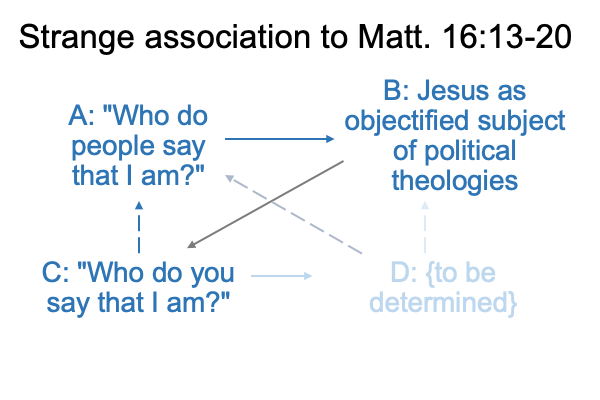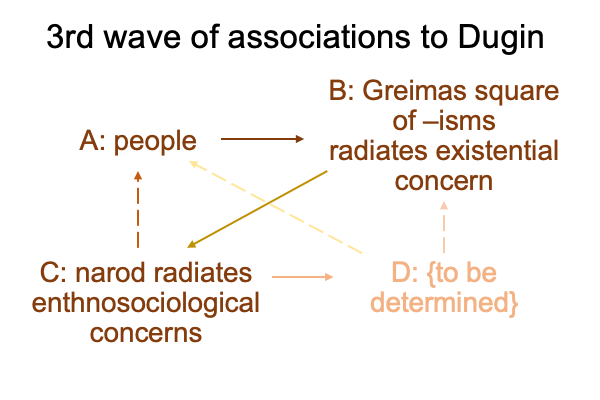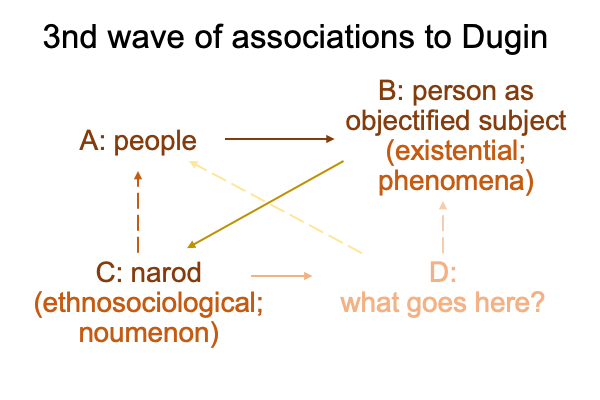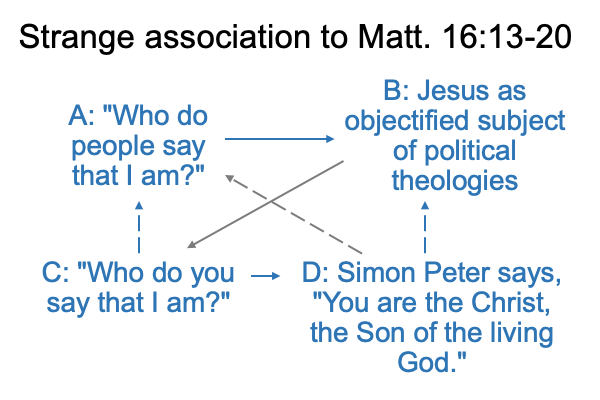Looking at Michael Millerman’s Chapter (2020) “Derrida” (Part 5 of 5)
0031 What about the second incident (point 0003)?
The next essay that Millerman reviews is titled, “Heidegger’s Ear”.
Here, Derrida waxes on a snippet in Heidegger’s book, Being and Time, that mentions the voice of a friend whom every Dasein carries with it.
0032 To me, if Heidegger’s leap really opens a vista into the Lebenswelt that we evolved in, then Heidegger would have used the word, “gesture”, rather than “voice”.
Or, maybe, the word, “voice” is okay, since, before the first singularity, humans practice hand-speech talk. Two modes of talking co-exist. Cultural tradition determines which mode is more appropriate for any particular social situation.
0033 Derrida reads German. So, he has an ear for Heidegger. German (B), like all spoken languages, carries a conceptual apparatus (D). So, Heidegger must allow Derrida into his pact (B), concerning openness to an inception (C), that is like a concept, but is not a concept, because it complements a secret (A) that makes us present (Da-) to being itself (-Sein) (D).
Because Derrida speaks German, he must be a “friend”. But, Derrida finds that naive, because he can also be an enemy. Derrida figures out that, if you speak the same language, then you can share secrets. Heidegger says “friend” in the most naive way, as if the word reflects a state before the duality of friends and enemies. It seems to me that Derrida could be a real enemy who infiltrated behind the defenses of an opposing camp. And, he knows it.
Derrida is a dangerous philosopher. Everyone respects Derrida. Everyone fears deconstruction. Derrida approaches Heidegger as a “friend”, who speaks the same language. Derrida knows that the fraternal order of philosophy has splintered. First, everyone is a companion (or a compatriot). Then, everyone is either a friend or an enemy. Heidegger marks this transition with a German word: Geschlect.
0034 According to Derrida, Geschlect is a “mark”, a sign of division, a yellow patch for some and no patch for others. Well, maybe the patch can be sex, race, species, genus, status, genealogy or community. The yellow/no patch dualityrelies on concepts (that is, explicit abstractions). Yet, certain phenotypic and physical tags are inceptual (that is, implicit abstractions). But, explicit abstractions end up justifying these implicit abstractions.
0035 Here, I can see the threat of Derrida’s genius. Concepts, as utterances2m [carrying] information2f, are manifestations of Saussure’s definition of spoken language, parole2m [arbitrary relation] langue2f. This implies that the apparent mechanical substance corresponding to [carry] is really grounded in the slippery substance of [arbitrary relation]. This is the nature of sensible construction in speech-alone talk.
Here is how Derrida’s Greimas square manifests as sensible construction.

0036 What does Geschlect do?
Geschlect traverses the topolitology of secrets. In the city of Geschlect, there is a factory, turning pre-political feelingsinto conceptualized divisions among people. Today, that factory is called “modern politics”. It is run by, for and of the government. But, it claims to be by, for and of the People. Compatriots become friends and enemies.
0037 The voice of the compatriot, Heidegger’s “friend”, is embedded in the constitution of the human. Prior to the first singularity, hand-speech talk relies on manual-brachial gestures. Solidarity is guaranteed by one’s gaze. Someone who word-gestures a falsehood is immediately exposed as one’s enemy. How so? Manual-brachial gestures are defined by what they picture or point to. Word-gestures do not define their referents. They picture and point to them.
In contrast, spoken words do not picture or point to anything.
0038 After the first singularity, spoken language relies on our innate sensibilities until… labor and social specialization starts to spin explicit abstractions, like threads on a spool, and speech becomes something like a secret. You have to know the relation between the utterance and the information, in order to be a member of the club. So, the arbitrary relation between parole and langue slowly, irrevocably, weaves the threads into conceptual apparatuses.
Everyone who speaks the same language starts as a compatriot. But, two parties emerge, ones who are in tune with the conceptual apparatus and the ones who still imagine that our words picture and point to their referents.
0039 Derrida discovers a secret within the secret. The conceptual apparatus is mechanistic. And, like all machines, it can be constructed differently. So, deconstruction is a technique to shake the conceptual apparatus, in order to expose the arbitrariness of its relations. Concepts divide us. Deconstructed concepts unnerve us.
Heidegger discovers the foundation of the secret. The secret is a pact, where information is known only by us, and that pact cannot be articulated in speech-alone words. Instead of a concept, where the utterance is a conspiracy, Heidegger proposes an incept, where the pact manifests as inspiration. An incept draws us into one inspiration.
0040 Heidegger has a word that is translated as “both strife and accord”. I suppose that strife labels the struggle to keep the vessel empty. I suppose that accord is the happy moment when the vessel is full. The word is “Walten“.
Or perhaps, Walten is the originating unity of two real elements. Perhaps I can imagine that these elements are —2m and vessel2f. So the unity or the contiguity is [empty]. But also, imagine the unity of …known only to us2m and vessel2f. The contiguity is [fill].
Either way, the originating unity of two real elements is inceptual.

No one can open someone else to an inception. Inception is where the seed of conviction germinates. No political philosopher has a recipe for an inceptual institution of the theologico-political domain. No one, except for Jesus, has torn the veil woven by explicit abstraction. In contrast, many theologians and politicians have quested for a magical token that empowers the veil and strands us in the domain of conceptual apparatuses.
0041 In our cutthroat world of concepts, people cling to their worldviews, ridicule other worldviews, and fail to notice that their conceptual apparatuses have closed them off from their inceptual heritage. Concepts pose as things that bring us into organization. But, is organization all there is?
Of late, the United States of America has a humorous tradition in this regard. They name legislative decrees with the conceptual apparatus that they are going to replace. For example, in 2001, the so-called “Patriot Act” is legislated and signed into law. Twenty years later, a surveillance-oriented bureaucracy identifies members of the “make America great again” movement as “domestic terrorists”.
Yes, the utterance of “domestic terrorists” institutes a concept that identifies patriots as enemies of thier surveillance state.
0042 What does this imply?
Is Walten like a secret, that is, information known only to us?
Then, as fast as I can say, “Geschlect.”, there are two parties. One party focuses on information. One party focuses on the “known only by us” business.
How can companions come together after established nomenclature turns everyone into either friends or enemies? As politics invades all aspects of society, each person asks, “Which worldview do I belong to?” Cognitive machinations hustle propaganda and apologetics. Some people get carried away. The last thing they want is to be cut from the pact. No one wants to get cut. Plus, true believers are willing to sacrifice others to their cause.
How does a people become a people?
I suppose that theologico-political topolitologies are required.
Plus, it seems as if the secret allows me to visualize the topolitology of a Walten, an originating unity of two realities.
Here is one reality, corresponding to “information…”.

0043 Here is the other element, corresponding to “…known only by us”.

When does a Walten solidify its current theologico-political domain?
An accord, seeking to be filled with a conceptual apparatus (D), leads to calcification and total domination.
When does a Walten liquify its current theologico-political domain?
A struggle to be open to being filled by God’s meaning, presence and message (H) leads to revelation and new life.
0044 To the extent that Derrida reads German, Derrida is Heidegger’s companion.
What does Derrida see?
Heidegger’s “friend” can speak as either friend or enemy. Geschlect says, “You are either friend or enemy.” Walten says, “Please, remain a companion.”
0045 In one fashion, Derrida’s and Heidegger’s theologico-political constructions mirror one another.
I suspect that Derrida stays his desconstructive hand in recognition of this reality.
In another fashion, these two theological-political constructions derive from a single, undifferentiated, realness, to which we, in our current Lebenswelt, can never return.
We need deconstruction to combat our march towards death by a totalizing conceptual apparatus.
We need inception to seed the fields of our open minds.
In the chapter on Derrida, Millerman finds good reason to start with Heidegger.
Recognize the possibility.










